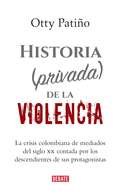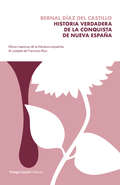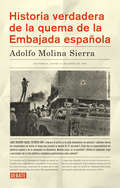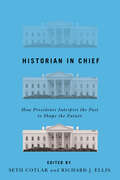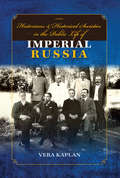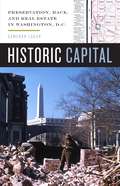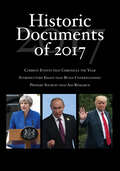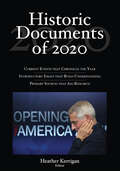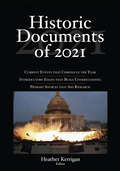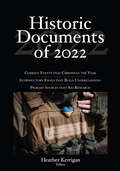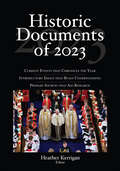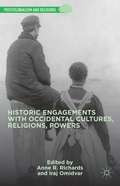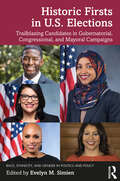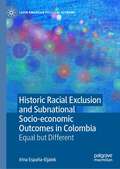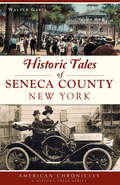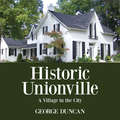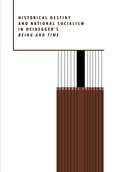- Table View
- List View
Historia (privada) de la violencia: La crisis colombiana de mediados del siglo XX contada por los descendientes de sus protagonistas
by Otty PatiñoA partir de 28 entrevistas a familiares de personajes claves de la historia de mediados del siglo XX, se reconstruye una huella, una herencia, que trasciende al país en conjunto, y que ha sido transmisora de afectos, frustraciones, prejuicios y temores que están en la base de la formación política. Este no es un libro de historia convencional. Acude a la subjetividad, a los recuerdos vivos para contar ocho años de la historia colombiana donde colapsaron tres importantes proyectos nacionales (1945-1953), que generaron pasiones políticas entre los colombianos y que sirvieron de justificación de la violencia que todavía padecemos. Es un enfoque innovador que reflexiona sobre las ideas infundadas en las muchas veces hostil historia de Colombia. "El mayor esfuerzo investigativo estuvo centrado en la parte subjetiva, en la huella que dejaron estos acontecimientos en el intelecto y el corazón de quienes, por razones de parentesco, recibieron más de cerca la herencia de las ideas, los sueños, las frustraciones, losamores y los odios de los principales protagonistas de estas historias. Esa huella trascendió también a muchos colombianos que recibimos querencias y malquerencias, frustraciones, prejuicios y temores que están en la base de nuestra formación política". Otty Patiño
Historia verdadera de la conquista de la Nueva España: Verdadera Historia De Los Sucesos De La Conquista De La Nueva Espa�a, Por El Capit�n Bernal D�az Del Castillo, Uno De Sus Conquistadores
by Bernal Diaz Del Castillo Francisco RicoEl descubrimiento y conquista de América fueron acontecimientos cruciales de incalculables consecuencias, aun hoy en vías de resolución. La Historia de la conquista de Nueva España es una crónica portentosa y minuciosa de un testigo directo de aquella empresa descomunal. El brío excepcional del relato, el vigor de la prosa y su infatigable capacidad para evocar hombres, acciones y escenarios le conceden, sin lugar a dudas, un sitio de privilegio en la literatura española. El libro contiene tres grandes bloques temáticos: el descubrimiento de Yucatán por las expediciones de Francisco Hernández de Córdoba y Juan de Grijalva (1517-18); la epopeya propiamente dicha bajo los estandartes de Hernán Cortes (1519-21); y el viaje a Honduras, complementado con una extensa miscelánea de noticias sobre la Nueva España. Cada página es un dechado de prodigiosa intensidad, producto del talento narrativo de Bernal Diaz, de la energía de su estilo y del terrible verismo con que narra la aventura. Nada queda fuera de su crónica en esta edición concentrada en sus mejores capítulos, que se incluyen por entero: ni las vicisitudes y sucesos militares, ni la caracterización de los personajes más relevantes (Cortes, Moctezuma, etc.), ni los sentimientos y experiencias personales de un soldado empeñado en dar exacta y precisa cuenta de los avatares vividos en esa tierra desconocida. Pero quizás la grandeza de esta obra radique en el aliento épico que la anima. A diferencia de otros cronistas, a los que se enfrenta y critica, Bernal Diaz presenta la conquista de México como una empresa común, como la gesta de un colectivo de hombres cuyos aciertos y errores corresponden al pueblo español.
Historia verdadera de la quema de la Embajada española
by Gustavo Adolfo Molina SierraLo sucedido en la Embajada de España no puede ser tomado como una coincidencia o casualidad. Por el contrario, todo se integra como parte de un plan, eso sí, mal ejecutado, que al salirse de control falló aparatosamente y causó una tragedia. Aun así se trató de sacar provecho de esta desgracia. Estos intentos mantuvieron el caso activo, pero no existió la voluntad política para investigarlo judicialmente hasta el 2014. Guatemala, jueves 31 de enero de 1980. ¿Qué sucedió en aquel fatídico día? ¿Ingresó la policía a la sede diplomática sin permiso? ¿Quienes fueron los responsables de iniciar el fuego que provocó la muerte de 37 personas? ¿Cuál fue la responsalibidad del gobierno español y de su embajador en Guatemala, Máximo Cajal, en lo sucedido? ¿Utilizó el embajador Cajal a personas de la vida política y académica guatemalteca como señuelo? ________________________________________________________________ A lo largo de 40 años, desde aquella lejana fecha del jueves 31 de enero de 1980, Adolfo Sierra Molina ha recopilado cuanta información se ha publicado relacionada con la ocupación y quema de la Embajada de España. Se convirtió también en una de las voces que desde el inicio expuso, a través de numerosos artículos y dando su testimonio una y otra vez, la versión de hechos de los que él fue testigo y que ha ido completando con las pruebas de personas que estuvieron presentes. Su padre, Adolfo Molina Orantes, un destacado abogado, académico, humanista y exfuncionario, murió tragicamente junto a otras 36 personas, entre las que se encontraban Eduardo Cáceres Lehnhoff, funcionarios españoles, personal guatemalteco, así como los que tomaron la sede diplomática desde las primeras horas de la mañana. Uno de los invasores fue encontrado con vida por los bomberos cuando ingresaron al despacho del embajador Máximo Cajal López, quien, minutos antes, había salido caminando de la habitación en la que se habían atrincherado. Adolfo Molina Sierra revela y analiza lo sucedido poniendo los puntos sobre las ies y señalando sin tapujos a los responsables en una historia que no es solo suya, sino también de Guatemala.
Historian in Chief: How Presidents Interpret the Past to Shape the Future
by Rick Perlstein John Milton Cooper Jr. Kathleen Dalton James T. Kloppenberg Jeffrey L. Pasley David Waldstreicher David Sehat Jonathan Earle Edward Countryman Charlie Laderman Elvin T. LimPresidents shape not only the course of history but also how Americans remember and retell that history. From the Oval Office they instruct us what to respect and what to reject in our past. They regale us with stories about who we are as a people, and tell us whom in the pantheon of greats we should revere and whom we should revile. The president of the United States, in short, is not just the nation’s chief legislator, the head of a political party, or the commander in chief of the armed forces, but also, crucially, the nation’s historian in chief.In this engaging and insightful volume, Seth Cotlar and Richard Ellis bring together top historians and political scientists to explore how eleven American presidents deployed their power to shape the nation’s collective memory and its political future. Contending that the nation’s historians in chief should be evaluated not only on the basis of how effective they are in persuading others, Historian in Chief argues they should also be judged on the veracity of the history they tell.
Historians and Historical Societies in the Public Life of Imperial Russia
by Vera KaplanWhat was the role of historians and historical societies in the public life of imperial Russia? Focusing on the Society of Zealots of Russian Historical Education (1895–1918), Vera Kaplan analyzes the network of voluntary associations that existed in imperial Russia, showing how they interacted with state, public, and private bodies. Unlike most Russian voluntary associations of the late imperial period, the Zealots were conservative in their view of the world. Yet, like other history associations, the group conceived their educational mission broadly, engaging academic and amateur historians, supporting free public libraries, and widely disseminating the historical narrative embraced by the Society through periodicals. The Zealots were champions of voluntary association and admitted members without regard to social status, occupation, or gender. Kaplan’s study affirms the existence of a more substantial civil society in late imperial Russia and one that could endorse a modernist program without an oppositional liberal agenda.
Historias de amor en campos de guerra
by Vanessa De La TorreEste libro reúne cinco historias que se entrelazan de mujeres que comparten un denominador común: la guerra. Vanessa De La Torre, una de las periodistas más destacadas del panorama actual, inició hace unos años una investigación que resultó en este libro. Historias de amor en campos de guerra reúne los testimonios de seis mujeres extraordinarias que por diversas razones terminaron siendo víctimas de un conflicto armado del que pensaron que nunca podrían librarse, y que, en medio de ese drama, vivieron intensas y memorables aventuras amorosas. De La Torre cuenta, por ejemplo, detalles de la vida de una mujer desplazada antes de llegar a convertirse en una de las cantantes de música popular más exitosas de los últimos tiempos; narra la apasionante aventura que vivió una joven junto al excomandante del M-19 Carlos Pizarro, y recrea los obstáculos que tuvo que enfrentar una exguerrillera que huyó del monte para seguir su corazón. En definitiva, todos los relatos aquí plasmados se entrelazan y, al tiempo que revelan un pasado marcado por la violencia, siembran la sensación de alivio y esperanza que dejan las verdaderas historias de amor. "Desde los más reconocidos protagonistas de nuestra barbarie hasta los más anónimos, el amor ha cruzado por la vida de estos personajes para dotarlos de una humanidad que parecía haber sido devorada por la violencia". Jorge Franco
Historic Capital: Preservation, Race, and Real Estate in Washington, D.C.
by Cameron LoganWashington, D.C. has long been known as a frustrating and sometimes confusing city for its residents to call home. The monumental core of federal office buildings, museums, and the National Mall dominates the city&’s surrounding neighborhoods and urban fabric. For much of the postwar era, Washingtonians battled to make the city their own, fighting the federal government over the basic question of home rule, the right of the city&’s residents to govern their local affairs. In Historic Capital, urban historian Cameron Logan examines how the historic preservation movement played an integral role in Washingtonians&’ claiming the city as their own. Going back to the earliest days of the local historic preservation movement in the 1920s, Logan shows how Washington, D.C.&’s historic buildings and neighborhoods have been a site of contestation between local interests and the expansion of the federal government&’s footprint. He carefully analyzes the long history of fights over the right to name and define historic districts in Georgetown, Dupont Circle, and Capitol Hill and documents a series of high-profile conflicts surrounding the fate of Lafayette Square, Rhodes Tavern, and Capitol Park, SW before discussing D.C. today.Diving deep into the racial fault lines of D.C., Historic Capital also explores how the historic preservation movement affected poor and African American residents in Anacostia and the U Street and Shaw neighborhoods and changed the social and cultural fabric of the nation&’s capital. Broadening his inquiry to the United States as a whole, Logan ultimately makes the provocative and compelling case that historic preservation has had as great an impact on the physical fabric of U.S. cities as any other private or public sector initiative in the twentieth century.
Historic Documents of 2017
by Heather KerriganFor more than 45 years, the Historic Documents series has made primary source research easy by presenting excerpts from documents on the important events of each year for the United States and the world. Each volume includes approximately 60 events with well over 100 documents from the previous year, from official or other influential reports and surveys, to speeches from leaders and opinion makers, to court cases, legislation, testimony, and much more. Historic Documents is renowned for the well-written and informative background, history, and context it provides for each document. Each volume begins with an insightful essay that sets the year’s events in context, and each document or group of documents is preceded by a comprehensive introduction that provides background information on the event. Full-source citations are provided. Readers have easy access to material through a detailed, thematic table of contents, and each event includes references to related coverage and documents from the last ten editions of the series. Events covered in the 2017 Edition include: The intricacies of the new presidential administration of Donald Trump Russian involvement in the U.S. presidential election U.S. and global policies on immigration and refugees Landmark Supreme Court rulings on gerrymandering and state grant money for parochial schools, and the appointment of Neil Gorsuch Global warming and climate change agreements and policies European elections, including those in the UK, France, and Germany Outcomes of the G-20 Summit North Korea and international calls to action Volumes in this series dating back to 1972 are available as online editions on SAGE Knowledge.
Historic Documents of 2020 (Historic Documents)
by Heather KerriganPublished annually since 1972, the Historic Documents series has made primary source research easy by presenting excerpts from documents on the important events of each year for the United States and the World. Each volume pairs 60 to 70 original background narratives with well over 100 documents to chronicle the major events of the year, from official reports and surveys to speeches from leaders and opinion makers, to court cases, legislation, testimony, and much more. Historic Documents is renowned for the well-written and informative background, history, and context it provides for each document. Organized chronologically, each volume covers the same wide range of topics: business, the economy and labor; energy, environment, science, technology, and transportation; government and politics; health and social services; international affairs; national security and terrorism; and rights and justice. Each volume begins with an insightful essay that sets the year’s events in context, and each document or group of documents is preceded by a comprehensive introduction that provides background information on the event. Full-source citations are provided. Readers have easy access to material through a detailed, thematic table of contents, and each event includes references to related coverage and documents from the last ten editions of the series.
Historic Documents of 2020 (Historic Documents)
by Heather KerriganPublished annually since 1972, the Historic Documents series has made primary source research easy by presenting excerpts from documents on the important events of each year for the United States and the World. Each volume pairs 60 to 70 original background narratives with well over 100 documents to chronicle the major events of the year, from official reports and surveys to speeches from leaders and opinion makers, to court cases, legislation, testimony, and much more. Historic Documents is renowned for the well-written and informative background, history, and context it provides for each document. Organized chronologically, each volume covers the same wide range of topics: business, the economy and labor; energy, environment, science, technology, and transportation; government and politics; health and social services; international affairs; national security and terrorism; and rights and justice. Each volume begins with an insightful essay that sets the year’s events in context, and each document or group of documents is preceded by a comprehensive introduction that provides background information on the event. Full-source citations are provided. Readers have easy access to material through a detailed, thematic table of contents, and each event includes references to related coverage and documents from the last ten editions of the series.
Historic Documents of 2021 (Historic Documents)
by Heather Kerrigan River Horse Communications, LLCThe Historic Documents of 2021 makes primary source research easy by presenting excerpts from documents on the important events of the United States and the World. The Historic Documents of 2021 pairs 60 to 70 original background narratives with well over 100 documents to chronicle the major events of the year, from official reports and surveys to speeches from leaders and opinion makers, to court cases, legislation, testimony, and much more. Historic Documents is renowned for the well-written and informative background, history, and context it provides for each document. Organized chronologically, it covers the same wide range of topics: business, the economy and labor; energy, environment, science, technology, and transportation; government and politics; health and social services; international affairs; national security and terrorism; and rights and justice.
Historic Documents of 2021 (Historic Documents)
by Heather Kerrigan River Horse Communications, LLCThe Historic Documents of 2021 makes primary source research easy by presenting excerpts from documents on the important events of the United States and the World. The Historic Documents of 2021 pairs 60 to 70 original background narratives with well over 100 documents to chronicle the major events of the year, from official reports and surveys to speeches from leaders and opinion makers, to court cases, legislation, testimony, and much more. Historic Documents is renowned for the well-written and informative background, history, and context it provides for each document. Organized chronologically, it covers the same wide range of topics: business, the economy and labor; energy, environment, science, technology, and transportation; government and politics; health and social services; international affairs; national security and terrorism; and rights and justice.
Historic Documents of 2022 (Historic Documents)
by Heather Kerrigan River Horse Communications, LLCPublished annually since 1972, the Historic Documents series has made primary source research easy by presenting excerpts from documents on the important events of each year for the United States and the World. Each volume pairs 60 to 70 original background narratives with well over 100 documents to chronicle the major events of the year, from official reports and surveys to speeches from leaders and opinion makers, to court cases, legislation, testimony, and much more.
Historic Documents of 2022 (Historic Documents)
by Heather KerriganPublished annually since 1972, the Historic Documents series has made primary source research easy by presenting excerpts from documents on the important events of each year for the United States and the World. Each volume pairs 60 to 70 original background narratives with well over 100 documents to chronicle the major events of the year, from official reports and surveys to speeches from leaders and opinion makers, to court cases, legislation, testimony, and much more.
Historic Documents of 2023
by Heather KerriganPublished annually since 1972, the Historic Documents series has made primary source research easy by presenting excerpts from documents on the important events of each year for the United States and the World. Each volume pairs 60 to 70 original background narratives with well over 100 documents to chronicle the major events of the year, from official reports and surveys to speeches from leaders and opinion makers, to court cases, legislation, testimony, and much more. Historic Documents is renowned for the well-written and informative background, history, and context it provides for each document. Organised chronologically, each volume covers the same wide range of topics: business, the economy and labor; energy, environment, science, technology, and transportation; government and politics; health and social services; international affairs; national security and terrorism; and rights and justice. Each volume begins with an insightful essay that sets the year’s events in context, and each document or group of documents is preceded by a comprehensive introduction that provides background information on the event. Full-source citations are provided. Readers have easy access to material through a detailed, thematic table of contents, and each event includes references to related coverage and documents from the last ten editions of the series.
Historic Documents of 2023
by Heather Kerrigan River Horse Communications, LLPPublished annually since 1972, the Historic Documents series has made primary source research easy by presenting excerpts from documents on the important events of each year for the United States and the World. Each volume pairs 60 to 70 original background narratives with well over 100 documents to chronicle the major events of the year, from official reports and surveys to speeches from leaders and opinion makers, to court cases, legislation, testimony, and much more. Historic Documents is renowned for the well-written and informative background, history, and context it provides for each document. Organised chronologically, each volume covers the same wide range of topics: business, the economy and labor; energy, environment, science, technology, and transportation; government and politics; health and social services; international affairs; national security and terrorism; and rights and justice. Each volume begins with an insightful essay that sets the year’s events in context, and each document or group of documents is preceded by a comprehensive introduction that provides background information on the event. Full-source citations are provided. Readers have easy access to material through a detailed, thematic table of contents, and each event includes references to related coverage and documents from the last ten editions of the series.
Historic Documents of 2024 (Historic Documents)
by Heather KerriganPublished annually since 1972, Historic Documents provides an unparalleled collection of primary sources that chronicle the most significant events of each year in the United States and around the world. Each edition features 60 to 70 original background narratives and more than 100 primary source documents—including official reports, speeches, legislation, court decisions, testimony, and more. Known for its exceptional editorial quality, the series offers expertly written context for each document, making primary source research accessible and meaningful. Organized chronologically, the volume covers key developments across a wide range of areas including politics, the economy, labor, international affairs, rights and justice, health, science, environment, and national security. A comprehensive introductory essay situates the year’s events, while full-source citations, a detailed thematic table of contents, and cross-references to the past decade of volumes enhance usability for researchers, educators, and students alike.
Historic Documents of 2024 (Historic Documents)
by Heather KerriganPublished annually since 1972, Historic Documents provides an unparalleled collection of primary sources that chronicle the most significant events of each year in the United States and around the world. Each edition features 60 to 70 original background narratives and more than 100 primary source documents—including official reports, speeches, legislation, court decisions, testimony, and more. Known for its exceptional editorial quality, the series offers expertly written context for each document, making primary source research accessible and meaningful. Organized chronologically, the volume covers key developments across a wide range of areas including politics, the economy, labor, international affairs, rights and justice, health, science, environment, and national security. A comprehensive introductory essay situates the year’s events, while full-source citations, a detailed thematic table of contents, and cross-references to the past decade of volumes enhance usability for researchers, educators, and students alike.
Historic Engagements with Occidental Cultures, Religions, Powers
by Anne R. Richards Iraj OmidvarThis book explores centuries of power relations and imperial and civilizing rhetorics, overarching themes highlighted in these infrequently heard accounts by eastern travelers to the West. Considered in depth are evolutions in mental frameworks and practices that led to the emergence of anticolonial consciousness and strategies of protest.
Historic Firsts in U.S. Elections: Trailblazing Candidates in Gubernatorial, Congressional, and Mayoral Campaigns (Race, Ethnicity, and Gender in Politics and Policy)
by Evelyn M. SimienHistoric Firsts in U.S. Elections:Trailblazing Candidates in Gubernatorial, Congressional, and Mayoral Campaigns examines barrier-breaking figures across various types of elective offices and constituent groups. The moment in which historic firsts enter the electoral arena, and the unique campaigns that ensue, are shown to be symbolically empowering. These change agents on the campaign trail become lighting rods for more liberal policies, and their candidacies are tied to questions of representation, electability, and performance. The distinctive combinations of race, ethnicity, and gender identities represented here translate into voter excitement to go to the polls and participate in other ways. Original chapters by respected scholars and practitioners consider how recent breakthrough elections are similar to yet different from past elections for gubernatorial, congressional, and mayoral offices. The shadow of Donald Trump’s wildly unconventional U.S. presidency looms over this groundbreaking analysis, linking local to national level politics. For students of politics across the curriculum, this book expands the theoretical capacity of intersectionality research and links it to voter mobilization and electoral success.
Historic Power Europe: A Post-Hegelian Interpretation of European Integration (Critical European Studies)
by Davide BarileThis book proposes a new theoretical framework to move beyond the traditional tenets of modern international relations theory to investigate European integration and shed light on current events. Based on contemporary analyses, Hegel’s political philosophy, and the fundamental role of historical interpretation, this book addresses the institutional dynamics as well as the discursive practices behind both the Eastern enlargement and the current critical situation. Looking back in particular at European integration in one of its most significant events, namely the enlargement of the European Union to include former Socialist countries, it offers a unique conceptualisation of the nature and limits of European integration and for understanding the current crisis between Brussels and the Visegrád countries, 30 years since the revolutions of 1989. This book will be of key interest to scholars and students of European integration, European politics and history, and political theory and philosophy.
Historic Racial Exclusion and Subnational Socio-economic Outcomes in Colombia: Equal but Different (Latin American Political Economy)
by Irina España-EljaiekThis book examines the geo-racialized order of the Colombian state and its consequences for Afro-descendant territories. To do so, it employs a historical institutional approach tracing racial exclusion and subnational socioeconomic outcomes in Colombia during the late nineteenth to mid-twentieth centuries. It uses a mixed-methods and interdisciplinary qualitative and quantitative analytical approach to identify the quantitative effects of informal racial exclusion on subnational collective outcomes, as well as to show more precisely how these effects were generated. Through its exploration of Colombia’s geo-racialized project, implicit exclusion of Afro-descendant territories and spatialized nature of racial diversity, this book contributes to literatures of Latin American political economy, institutional theory, racial politics and economic history.
Historic Tales of Seneca County, New York (American Chronicles)
by Walter GableLocated in the Finger Lakes region of New York, Seneca County has a fascinating history. Early settlers courageously fought off wild animals from wolves to panthers to tame the land and keep the new settlements safe. The rise and fall of the mill industry led to the demise of ghost towns like the Kingdom. The jailhouse murder of John Walters in 1887 fostered improved conditions in the county jail. From the first home-run hitter in major-league baseball to the insidious activity of the Ku Klux Klan in the 1920s and the unfortunate burning of a traveling embalmed whale, author and historian Walter Gable shares many of the defining moments of Seneca County history.
Historic Unionville: A Village in the City
by George DuncanA guided tour of historic Unionville, a little Ontario village bursting with historic buildings full of stories. Unionville is a village in the city — an unexpected oasis where time seems to move a little more slowly than in the hectic world of condos, commercial strips, and traffic gridlock. Since the late 1960s, when Unionville and its vintage Main Street were “discovered,” the village has been a magnet for visitors. Historic Unionville is the first detailed exploration of the facts and folklore behind Unionville’s winding ways and eclectic architectural sights, which span two centuries from the Georgian to the Postmodern. Touring the heritage sites that still stand proudly in the community as signposts to the past, George Duncan brings to life stories of the people, places, and events behind this unique and inviting Ontario village.
Historical Destiny and National Socialism in Heidegger's Being and Time
by Johannes FritscheThere has been much debate over the relationship of Heidegger's philosophy—in particular his book Being and Time—to his practical involvement with National Socialism. Yet the question has never been addressed through a comparison of Being and Time with other texts on history and politics written at the time. Johannes Fritsche does this, providing a detailed interpretation of the relevant passages in Being and Time—especially sections 72-77 on fate, community, and society. He analyzes for comparison two other authors who explicitly regarded themselves as rightists—Adolf Hitler (Mein Kampf) and Max Scheler (Formalism in Ethics and other writings)—and two authors on the left—Georg Lukács (History and Class Consciousness) and Paul Tillich (The Socialist Decision).Fritsche concludes that Being and Time is a brilliant summary of right-wing politics in general, which proposes the destruction of liberal society in order to regenerate an idealized community. In addition, Heidegger rejects positions on the right, such as Scheler's, that enabled their authors to distance themselves from the most extreme political rightists, and thus he paves the way for National Socialism. Being and Time, Fritsche demonstrates, must be seen as a clear case for the National Socialists and their project of revitalization of the Volksgemeinschaft, the community of the people.
